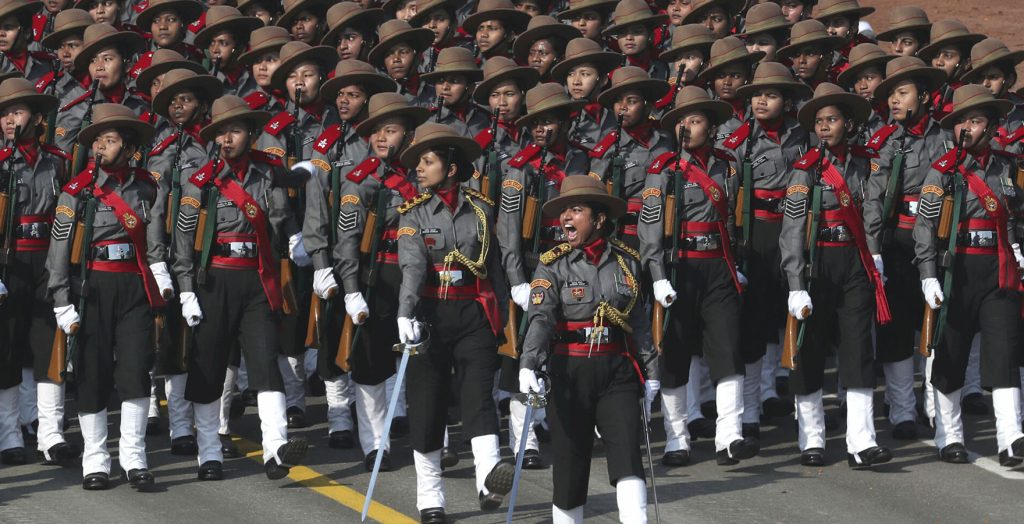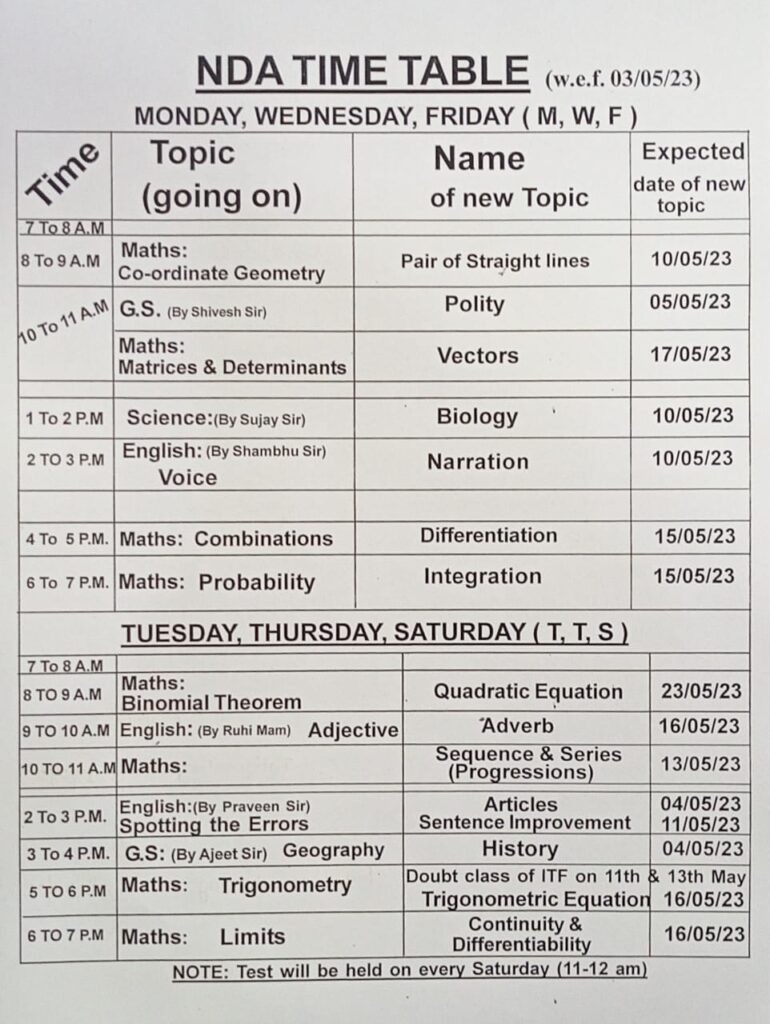The UPSC holds entrance Examination twice a year for entry into the NDA and NA. Candidates on completion of 10+2 examination or while in the 12th standard are eligible to compete. Having cleared UPSC written examination, eligible candidates undergo Service Selection Board (SSB) interview for five days. On being medically fit and coming in NDA merit list, successful candidates join the NDA or NA as per their option of service exercised at the time of applying. On completion of the course, they are sent to the respective Service Academies for their pre-commissioning training.


Subjects
Math’s (11th & 12th level)
GAT
English
G.A (History, Geo, Polity, Eco, Phy, Chem, Bio)
Exam Phase – I
Written
Maths – 120 questions (2.5 hours )
GAT – 150 questions (2.5 hours )
Mode
offline
Phase II
SSB ( 5 days )
Phase III
Merit list + Joining
Both Male & female are eligible
Age Limit (16.5-19.5 yrs )
| NDA Syllabus for Mathematics (Paper 1) | |
| Algebra | Set theory, set operations, and Venn diagrams.De Morgan laws, relation, and the Cartesian product of equivalence.Real numbers represented on a line.Basic characteristics, modulus, argument, and cube roots of unity of complex numbers.Binary number system.Conversion of a number between the binary and decimal systems.Progressions in geometry, harmony, and arithmetic.Real-coefficient quadratic equationsGraph-based solutions to two-variable linear equations.Combination and Permutation.The binomial theorem and its uses.Applications for logarithms. |
| Matrices and Determinants | Matrix types and Matrix operationsBasic characteristics of determinants, a matrix’s determinant.Inverse and adjacent to a square matrix.Applications include the use of Cramer’s rule and the Matrix method to solve a system of linear equations with two or three unknowns. |
| Trigonometry | Angles and their degrees and radians measurements.Ratios of trigonometry.Formulas for the sum and difference of trigonometric identities.Sub-multiple and Multiple angles.Trigonometric operations in inverse.Applications include height and distance as well as triangular properties. |
| Analytical Geometry of two and three Dimensions | Cartesian coordinates with a rectangular shape.Distance calculation.Many variations of a line’s equation and angles between two lines.A Point’s separation from a line.Circle equation in standard and general form.Parabola, ellipse, and hyperbola in their standard forms.A conic’s eccentricity and axis.Distance between two points at a point in three dimensions.Cosines and ratios of directions.Equation for two pointsDifferent equations involve a plane and a line.Angles between two planes and two lines.Equation for a sphere. |
| Differential Calculus | Real-valued function concept, including domain, range, and function graph.Functions that are composite, one-to-one, onto, and inverse.Examples of a limit concept and standard limits.Examples and algebraic operations on continuous functions for the concept of function continuity.Applications for the geometrical and physical interpretations of a derivative of a function at a point.Derivatives of a function with respect to another function, derivatives of the sum, product, and quotient of functions, and derivatives of composite functions.Derivatives of the second order.Functions for increasing and decreasing.Application of derivatives to maxima and minima problems. |
| Integral Calculus and Differential Equations | Standard integrals using algebraic expressions, and trigonometric, exponential, and hyperbolic functions include integration as the inverse of differentiation, integration by substitution, and integration by parts.Applications for evaluating definite integrals include calculating the areas of flat regions bordered by curves.Definition of a differential equation’s order and degree, as well as examples of how to construct one.Examples include the general and specific solutions to differential equations, as well as the solutions to first-order and first-degree differential equations of various forms. application in growth and decay problems. |
| Vector Algebra | Vectors in two and three dimensions, including a vector’s magnitude and direction.Unit and null vectors, vector addition, vector scalar multiplication, scalar product, or dot product of two vectors are all examples of vectors. Cross product of two vectors, or vector product.Applications include the work carried out by a force and its moment, as well as geometrical problems. |
| Statistics & Probability | Statistics Data classification, frequency distribution, and cumulative frequency distribution and their examples.The graphical representation includes frequency polygons, histograms, and pie charts and their examples.Mean, median, and mode constitute central tendency measures.Comparison and determination of variance and standard deviation.Correlation and regression.ProbabilityRandom experiment, events, mutually exclusive and exhaustive events, outcomes and associated sample space, impossible and certain events.Intersection and Union of events.Elementary, Complementary and composite events.Examples and a definition of probability, both classical and statistical.Simple problems with basic probability theorems.Simple problems include conditional probability and Bayes’ theorem.Using a random variable as a sample space function.Examples of random experiments that gave rise to the binomial distribution |
| NDA Syllabus for English – Paper 2 (Part A) |
| Reading Comprehension & cohesion Questions.Cloze Test QuestionsSpotting the Error Questions.Fill in the Blanks Questions.Synonyms & Antonyms and Vocabulary Questions.Idioms and Phrases Questions.Sentence Arrangement or Para Jumbled Questions.Ordering of words in a Sentence Questions.Sentence Improvement or Sentence Correction Questions.Grammar and their usage type Questions |
